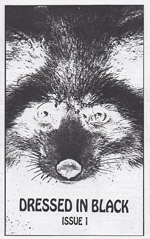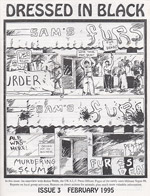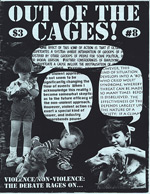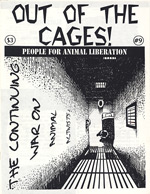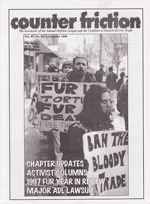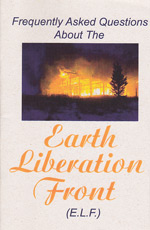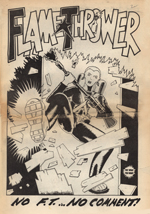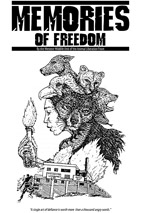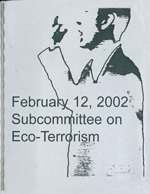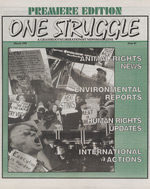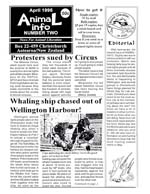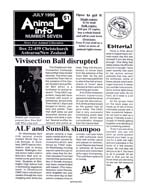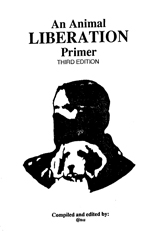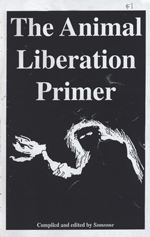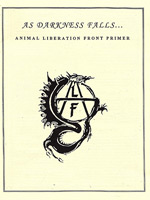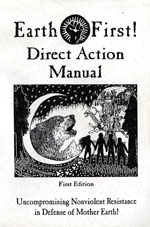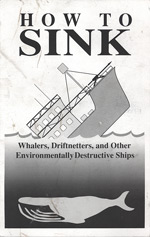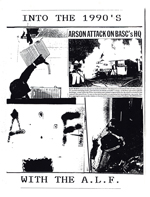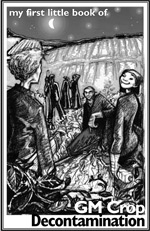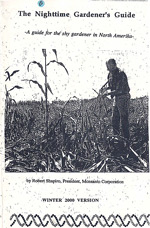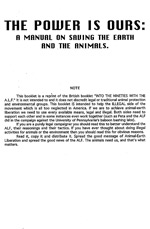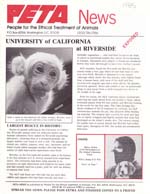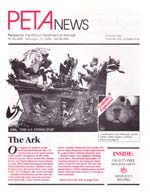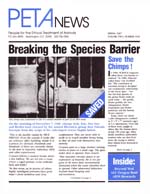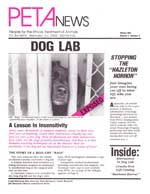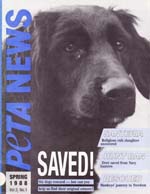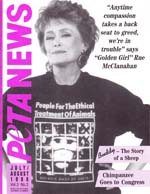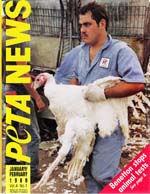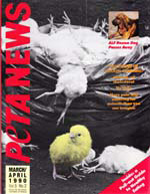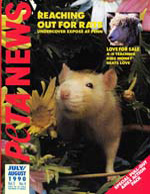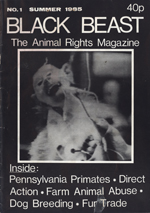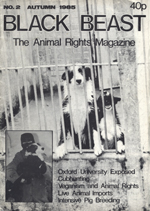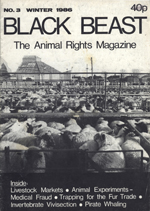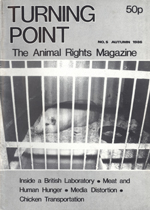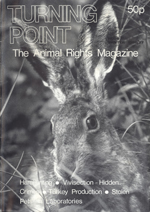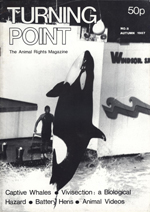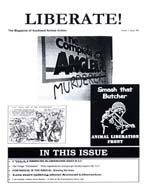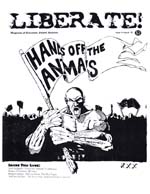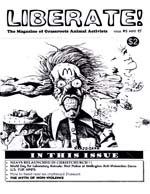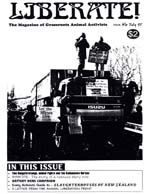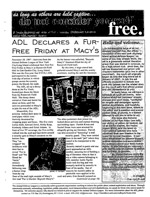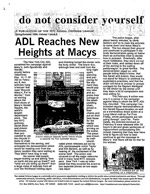Dressed in Black was more heavily distributed than other animal lib zines of its era due to the fact that Syracuse band Earth Crisis allowed members of the Syracuse ADL to leaflet their shows in the city, and took copies on tour with them in the mid-90s. Sadly, this zine died before reaching maturity, but the complete collection lives on in our archive.
Civil Disobedience
Out of the Cages
Out of the Cages 6-9 (1993-1994. Santa Cruz, CA. USA)
Although issues 1-5 of Out Of The Cages are said to be mostly local organizing bulletins we would still love to complete our set. If you have them- or other publications of note- please contact us!
The One Off Collection: A-F
ALF is Watching and there’s No Place To Hide, The (1988 – Laguna Beach, CA) Punk record and zine unfortunately produced by Sean Muttaqi, the founder of an anti-gay, anti-abortion tendency known as Hardline. This effort precedes his time as a cult leader, and minus his association with it, the record isn’t bad!
A Little is Enough, A Zine By Antarctic Sailors (2012/2013. The Southern Ocean) Written by the crew members aboard the Sea Shepherd vessel M/Y Bob Barker. This is the side of Sea Shepherd that people do not see on Whale Wars: the dedicated crew members who see Animal Planet executives as “prodouchebags,” who discuss issues of race and gender with each other on long, icy nights. Plus, SODUKU!
A.L.F. On Trial – Capitalism Under Attack In The 1980’s (1987. City of publication unknown, England) On February 5th of 1987 ten British animal liberationists were sentenced to an aggregate of 38 years after a trial prosecutors had designed to “break the back of the ALF.” This case, popularly referred to as the Sheffield Trial, set precedents not only in the UK, but worldwide for the manner in which vegan militants would be tried by the state and media. An anarchist analysis of the court proceedings from 1987 has survived in the form of this brief, snarky pamphlet.
Cascadia Forest Alliance Disorientation Manual (2003. City of publication unknown, likely Eugene, OR. USA) Militancy in defense of the planet is an artform, and this publication from the Cascadia Forest Alliance aimed to bring the basics to the masses who showed up at camps in the woods, eager to get active. It explains the basics of anti-oppression policies, direct action, consensus decision making, and security culture.
Counter Friction (1998. Bloomington, IN. USA) A joint effort between Coalition to Abolish the Fur Trade and the Animal Defense Leagues, Counter Friction was published during a period of internal conflict in the movement that led to lower participation and folded after a single issue.
Elaho Valley Anarchist Horde on the end of the 7Cs: A Journal of Sasquatchology (2001, Victoria, BC Canada) The end of the 90s and the early 2000s was a busy time for forest defenders, and across the globe direct action campaigns for wilderness were abundant and inspiring. There are many famous examples, and while Warner Creek and the anti-roads campaigns of England may have stolen the spotlight, one rugged crew in British Columbia carried on an overlooked battle that every activist should know about. If you like raging warrior grannies, sabotage, unlikely coalitions, and open revolt against corporations and their governmental subsidiaries, then you ought to read up on the history of actions in the Elaho, Squamish, and Simms valleys.
FAQ About the Earth Liberation Front (2001, Portland, OR. USA) A short FAQ on the ELF from the perspectives of Craig Rosebraugh and Leslie James Pickering.
Flamethrower (1986. London, England) We received this publication from another archivist but have very little information about its origins. Still, with a flame throwing, angry feminist on the cover how can you go wrong? If you have more information about Flamethrower please contact us!
The One Off Collection: M-R
Memories of Freedom (Publication year unknown, likely 1997. Tucson, AZ. USA) Rod Coronado’s once-anonymous account of Operation Bite Back, he later confessed to being the author. Beautifully written, but at times inaccurate, readers would do well to follow this zine with Operation Bite Back by Dean Kuipers for a less propagandized account of the campaign.
Nonviolence and Its Violent Consequences (2000. Gualala, CA. USA) A short and concise argument against dogmatic nonviolence and its use in wilderness campaigns.
North American Earth Liberation Front Press Office Subcommittee on Eco-Terrorism (2002. Portland, OR. USA) In the late 1990s environmental sabotage was happening all across the world, but was particularly frequent in the northwest of the United States. At the forefront of these actions was the Earth Liberation Front, an anonymous, underground group who utilized above ground spokespeople to reach the public. Their primary conduit for media relations was an activist from Portland named Craig Rosebraugh and his organization, the North American ELF Press Office. For his role in publicizing the motivations and rhetoric of the ELF he had his arm broken by the police, his home raided by Joint Terrorism Task Forces, his break cables cut, was repeatedly subpoenaed to grand juries, and eventually was called to testify before a congressional sub-committee who hoped to imprison him on contempt charges. The so-called “Eco-Terror committee” surely hoped that Craig would be an easy target, but that didn’t exactly work out for them. Snarky, educated, and angry, Craig’s testimony ran the gamut from stonewalling, to educational, to hilarious. For example, while running the Press Office with his friend Leslie James Pickering, Craig owned a bakery. When asked how the press office was funded, Rosebraugh simply replied “muffins.” When asked who had asked him to become the ELF press officer and how he was contacted, Craig responded, “Jesus Christ. It was a spiritual sort of thing.” This booklet is an in depth overview of the hearings and a rare piece of history with fewer than 500 physical copies printed.
One Struggle (1997. Boulder, CO. USA) Launched in 1997, One Struggle was meant to be a multi-issue alternative to the popular No Compromise magazine. With a mission to “fight the overall power structure,” the magazine produced only one issue which greatly failed in that task. It was almost exclusively authored by animal liberationists discussing the movement they most identified with, and many of the articles about other struggles were likewise written by single issue participants in those movements and lifted directly from their publications. This doesn’t mean that One Struggle was not a worthwhile read. The international coverage exceeded what was available in any other US AR zine at the time, and the classic “Non-violence is ass kissing” op ed still produces some hearty chuckles.
Raggedy Anarchy’s Guide to Vegan Baking and the Universe (Publication year unknown, likely 1989. Carmichael, CA. USA) Raggedy Anarchy will help you make delicious cakes, but it will also spark your desire to subvert the omnicidal paradigm! Sometimes funny, sometimes introspective, and always inspiring, we post this classic in the hopes of making Snacktivism a threat again and convincing our readers to “bake for themselves what tomorrow never brings!”
The Complete Animal Info
Animal Info 1-8 (1995-1996. Christchurch, New Zealand)
Still, Animal Info is an example of committed (but imperfect) activists organizing on a grassroots level and agitating against speciesism. Its international news coverage was impressive given the limited number of pages, and nicely bridges the U.S. coverage lapse between the time Open the Cages stopped publication and No Compromise began.
The Primer Collection
An Animal Liberation Primer, 2nd and 3rd Editions (Publishing dates unknown. Country of origin unknown) Popular primer widely distributed in the 1990s. Focused on security culture, direct action philosophy, tactical decision making between animal rescues and economic sabotage, and how-to directions.
Animal Liberation Primer, The (Publishing date unknown. Country of origin likely USA) Containing material mostly culled from other similarly named primers, this is a short how-to guide for small scale property damage, arson, and liberations. Contains a basic run down of security measures, mental preparation, and history of the Animal Liberation Front.
Animal Liberation Through Direct Action (Date of publication likely 1998. Country of origin likely England) One of the better primers available in the 1990s, the pamphlet discusses the basic security, surveillance, and planning necessary to carry out liberations and economic sabotage. Also includes a brief history of the movement, a first hand account of a mink farm raid, and statements from various ALF cells.
As Darkness Falls (1995, USA.) Dangerous, amateurly written, likely made by people with little personal experience utilizing direct action.
Earth First! Direct Action Manual 1st Edition (1997. Eugene, OR. USA) Earth First! chapters on the west coast of the United States won a few campaigns using blockading and civil disobedience in the 80s and 90s. As word spread about new tactics developing in the forests there was a clamor from other activist groups to build their own lockboxes, barrels, tripods, and “black bears.” The DAM Collective answered this demand by printing the Earth First! Direct Action Manual, a nicely illustrated, bound book containing how-to instructions on scouting, security, dealing with police, and setting up voluntary arrest scenarios utilizing “lock downs.” It also contained short articles about Critical Mass, The Animal Liberation Front, varying theories on non-violence as an ethic vs. tactical choice, and practical security measures for activists.
Going Underground for Animal Liberation (1993. England) Thoughts on animal liberation, the value of direct action, and security measures.
How to Sink Whalers, Driftnetters, and Other Environmentally Destructive Ships (1993. Chico, CA. USA) The scuttling of ships used to harm the ocean has a long and proud tradition in our movement. Classically, large boats were sunk with limpet mines attached magnetically to their hulls, but another method became popular in 1986 when David Howitt and Rod Coronado sank two boats in harbor in Iceland by opening the sea water intake valves. Their method, originally published as an epilogue in later editions of Dave Foreman and Bill Haywood’s Ecodefense, was later excerpted for publication in this zine format gem.
Interviews with ALF Activists (1986. England) According to Keith Mann, Interviews with Animal Liberation Front Activists had an initial print run of around 1,500 copies which were mailed to to the postal boxes of supportive groups. Inside were detailed instructions on fire bombs, as well as press clippings and interviews with the people behind much of the resistance taking place in England. Readers will notice pages missing from our .PDF of “Interviews.” After many years of photocopying, the final several pages- which contained addresses of laboratories- had become obsolete. In fact, many of them were out of date at the time of publication as they had been taken from documents issued by the Home Office 5 years prior to printing.
Into The 90s With The ALF (1991. England) Basic cut and paste primer from early 1990s. Discusses the course of direct action and hunt sabotage after the murder of Mike Hill.
Meeting the People and Ideas of the Animal Liberation Movement (Publication date unknown. Amsterdam, Netherlands) Containing mostly reprints from early issues of No Compromise, this is a good read with a mouthful of a title!
My First Little Book of GM Crop Decontamination (Date of publication likely 2002. Country of publication likely England) Essentially a more complete, British version of The Nighttime Gardener with illustrated instructions on locating and destroying genetically modified crops.
Nighttime Gardener (2000. United States) Originally released to coincide with the WTO protests, Nighttime Gardener quickly became the standard primer on anti-bioengineering crop pulls. These actions, which were once popular all across the world, were aimed at preventing GM cross contamination with other plants and corporate control of agriculture.
Power is Ours, The (Publication date unknown. Country of origin unknown.) Basically a reprinting of the Into the 90s with the ALF with a new lay-out and introduction. Contains a small piece about a raid carried out against the Oxford University vivisection program where 64 cats were rescued.
This Is The ALF 1-2 (1990, 1994. New Zealand) A brief snapshot of the animal liberation movement in New Zealand from the late 1980s into the 90s. The Diary of Actions is impressive for a country of this size.
We are still seeking primers. If you have them- or other publications of note- please contact us!
PETA News: the radical years.
PETA News, Various issues (1985-1990. Washington, D.C.)
“When questioned on Irish television about an action against a butcher shop, Morrissey, an avid vegetarian, was asked “What about the safety of the butchers?” Responded Morrissey, “When you think of the horror experienced by millions of animals in slaughterhouses each year, what’s a few butchers?” His song Meat Is Murder topped the charts in 1985.” PETA News Volume 3 #1
Imagine for a moment that a young animal rights activist with very little knowledge of the movement’s history finds a time machine and heads back into the early 1980s. Upon arrival they decide to get involved with a militant group and begin asking who they should join. At every turn they are told that PETA is the most militant group in the United States. This seems absurd to our young activist! “All PETA does is embarrass the movement with offensive ad campaigns and nudity! They are celebrity driven and devoid of substance, they kill healthy feral cats and don’t even have a rights based philosophy! They even demoted an employee for publicly supporting politically motivated arson!” Angered, our imaginary friend stomps into the DC area offices of the group to re-write history, and is shocked with what they find…
People for the Ethical Treatment of Animals experienced a meteoric rise in membership and notoriety in the early 1980’s as a direct result of their support for (and participation in) illegal direct action. Their relationship with the Animal Liberation Front was symbiotic: PETA provided the ALF with whistlebower information, credible spokespeople, and sympathetic coverage of raids. In return, PETA was placed in the media spotlight and received undercover footage and documents from the ALF that were often parlayed into high profile (and lucrative) campaigns. The atmosphere of popular militancy was exciting, and after years of slow progress people felt that supporting PETA meant backing a faster, more direct path to rights for non-humans.
PETA sold ALF support merchandise in their newsletters, ran a legal defense fund for people accused of unlawful activism, and helped popularize the concept of mischief in defense of animals. For example, PETA News sold squirt bottles of red permanent fabric ink alongside the warning that since the damage done to furs would be permanent, you should only spray the ink on your own furs! Articles talked about a likely apocryphal 15 year old who got grounded for passing out “Throw a Brick Through McDonald’s Day” pamphlets, and later chuckled as he got caught with paint bombs under his bed. Incidentally, the same article described how young “Kevin” made the paint bombs. These examples only just barely scratch the surface of the early militancy of Alex Pacheco and Ingrid Newkirk’s fledgling organization.
The story of animal rights in the United States can not be told without a thorough examination of the early days of PETA, an era sure to shock newcomers. In the coming months we will begin a more in depth analysis of their early days, but in the meantime jump into the time machine and prepare to have your mind blown by these early issues of PETA News.
Black Beast / Turning Point
Black Beast 1-3 / Turning Point 5-8 (1985-1987. Oxford, UK)
We are still seeking additional issues Turning Point. If you have them- or other publications of note- please contact us!
The Complete Liberate!
Liberate! 1-7 (1996-1997. Birkenhead, New Zealand)
Liberate! was written by a small group of dedicated activists. The content may have been produced by amateurs but there are some stand out articles about the burgeoning pro-direct action grassroots, conflicts between environmentalists and animal liberationists, and some entertaining imagery as well.
The Complete Do Not Consider Yourself Free
Do Not Consider Yourself Free 1-3 (1997 – 1998. New York, NY. USA)
Animal liberationist is proud to present the complete set here along with an introduction by Ryan Shapiro:
“The late 1990s was a different world, and the NYC Animal Defense League rocked that world. Working closely with the Long Island, New Jersey, Connecticut, and Syracuse chapters of the ADL, as well as with the NYU animal rights organization SEAL, the NYC-based Wetlands Animal Rights Action Team, and DC-based Compassion Over Killing, NYC ADL warred against animal exploitation and abuse in New York City.
NYC ADL sought to combine the aggressive militancy that characterized the grassroots animal rights movement of the late 1990s with a parallel focus on strategic and tactical planning. Our goal was to be both radical and smart. Efficacy was our watchword. As such, NYC ADL members could be found in camos while recruiting at Earth Crisis shows and in suits and dresses while occupying the President’s office at NYU (even if we still had Firestorm playing on the President’s stereo).
We placed particular emphasis on our civil disobedience actions. In the heady days before 9-11 and the Animal Enterprise Terrorism Act, NYC ADL organized seemingly ceaseless opportunities to challenge animal exploitation by locking ourselves to things. Through boldness of vision, obsessive attention to detail, and the courage of our membership, NYC ADL sought to perfect the art of the urban blockade. Whether it was learning the science of concrete solidification or busting out the algebra to determine the optimal participant distribution for a lockdown, NYC ADL devoted ourselves to coordinating spectacular acts of civil disobedience that served as models for other groups around the country. Among our proudest accomplishments was to repeatedly shut down the world’s largest store, Macy’s Herald Square, in protest of Macy’s continued sale of fur.
Due primarily to the departure from NYC of many of ADL’s leading coordinators, the group began to falter in 2000. Even in its demise, however, NYC ADL served as a feeder for some of the most significant grassroots animal rights campaigns of the new millennium. After leaving NY, veterans of NYC ADL served as key participants in, amongst others, the SHAC campaign, the campaign to shut down Makah whaling, and the campaign to expose factory farming through “open rescue.”
Over a decade later, NYC ADL seems both like yesterday and a lifetime ago. In either form of memory, however, I remain deeply humbled to have served alongside activists so passionate and dedicated. It is truly one of the great honors of my life to have been a part of NYC ADL. Thank you to everyone who fought for animals alongside us, and to everyone who continues the fight today. NYC ADL is gone, but the message lives on: As long as others are held captive, do not consider yourself free.”

